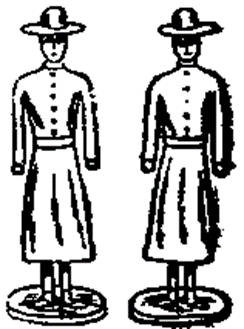This article has been transcribed from a copy of the Cardiff Times in the online collection of scanned Welsh newspapers 1804-1919 in the National Library of Wales, with grateful recognition of the free access accorded to all readers. —— David Skilton

o an observant man the contrasts of life form a most interesting and varied study. They are to be found in plenty in every walk of life, and they are not to be put on one side or crushed out of existence by the decrees of class or the desires of the multitude. They live on through all the ages, and they are as well worth observing to-day as they were hundreds of years ago.
Nowhere is the law of contrast more potent that in the world of Art, for it is the keystone of the painter’s success, and plays no small part in the efforts of the sculptor and the musical composer.

A contrast
Let us look at the method in which a painter builds up the structure of his pictures, and we shall find that he is largely guided in his composition by the law of contrast. Light and shade are contrasted by the clever artist with such effect that he produces a result that at once pleases the eye and appeals to the sense of the lover of the beautiful. Were he to discard the law of contrast, he would, in all probability, produce a crude and inartistic picture – a jumble of bad composition, bad colour, and unskilled manipulation.
In the world of the drama, the law of contrasts is even more strongly marked than in the world of Art.

No Contrast
The dramatic author has to consider his contrasts at all points of the game. Firstly he must take care that his scenes contrast favourably with each other so as to prevent monotony to the spectator and lack of interest in the surroundings of his puppets. Then in his play itself the dramatist is largely guided by the law of contrast, for were he to introduce into his piece characters alike in construction he would go a long way towards ensuring a failure for his drama. Contrast is the key-note of dramatic construction, and no play can hope to succeed which does not contain contrasting foils for each of its principal characters.
This law of dramatic contrasts is one that the young playwright cannot learn too early, as it is one that he should not – though he frequently does – neglect if he hopes to succeed in the profession.
No one know better than the artistic actor the value of contrast and the finest of the present day players, and particularly those whose line lies in the direction of 'character acting,' have one and all shown the keenest sense of contrast in their method of making-up and playing the various parts allotted to them.

Believes in Matches
So much is that so, that actors frequently try to teach the lesson of contrast to the public by appearing on the same evening in two parts of an entirely opposite nature, thereby enforcing the law of contrast in the most vivid and tangible manner. But for contrast the characterisation of the stage would become monotonous and the actor’s art a mere repetition of itself. In ordinary costumes, and more especially with those displayed by the daughters of Eve, it was year ago considered a sin qua non [necessary condition] that everything should match, and many a weary shopman has had a trying half-hour in endeavouring to find a match for some piece of material bought by a customer who wanted it matching.

Likes Things to Match
To-day, I am inclined to think, the law of contrast plays a more prominent part in the dressing of our womankind that it has ever before, and properly so, too, for if a woman studies it in her design and arrangement of a costume, she is far more likely to produce an artistic result than she would do if she worked on the old-fashioned principle of having every part of her garments made to match. Some of the most effective dresses I have ever seen, either on the stage or in private life, have been daring examples of the law of contrast. It is seldom that an allegiance to its [******] results in failure, and the number of striking successes produced by its means far outnumber those accruing from the monotonous and less artistic method of matching. In life the contrasts are of the most striking nature and form a subject worthy of study from the most intellectual of men, and women.
Riches and poverty, success and failure, misery and [j]oy, are all contrasts calculated to interest the thinking man, while a broken faith as contrasted with a trusting manhood affords perhaps the most startling example of the law of contrast that it is possible to desire.
Last modified 11 May 2022